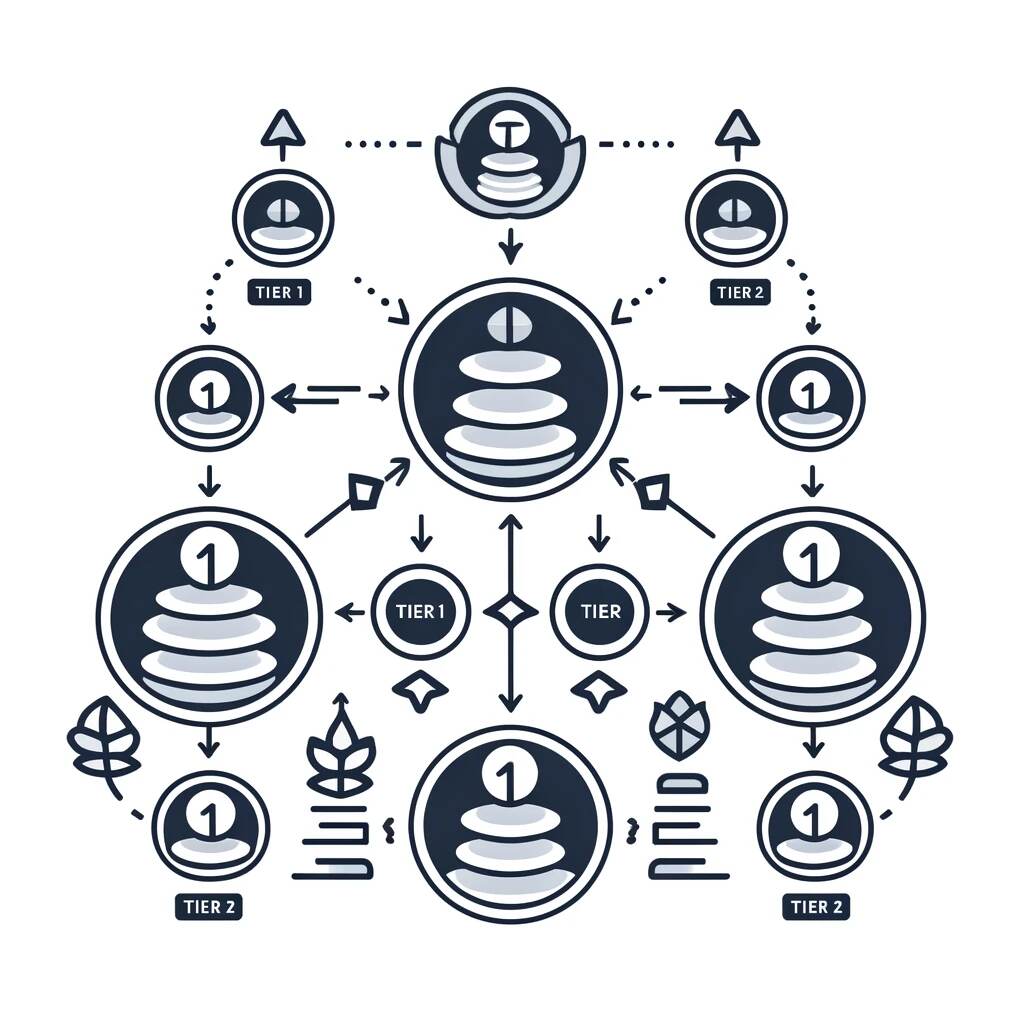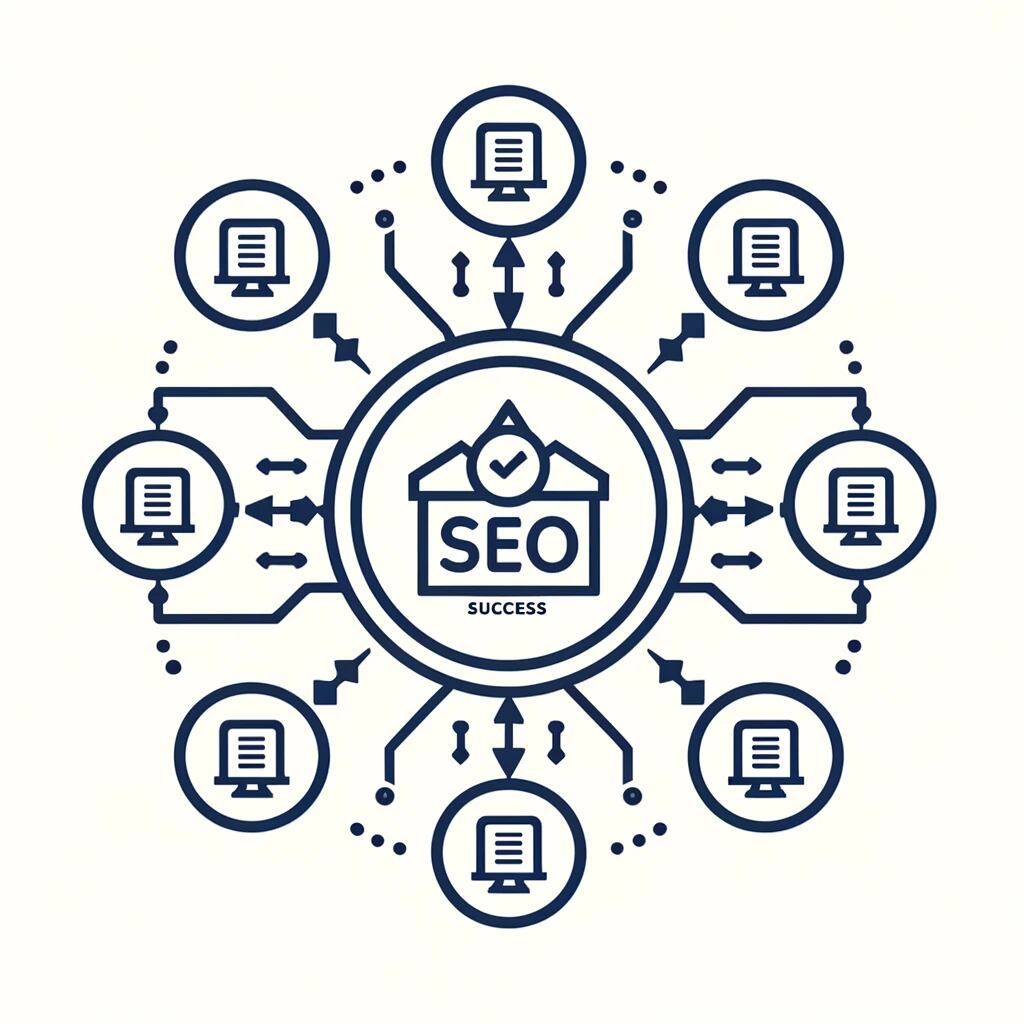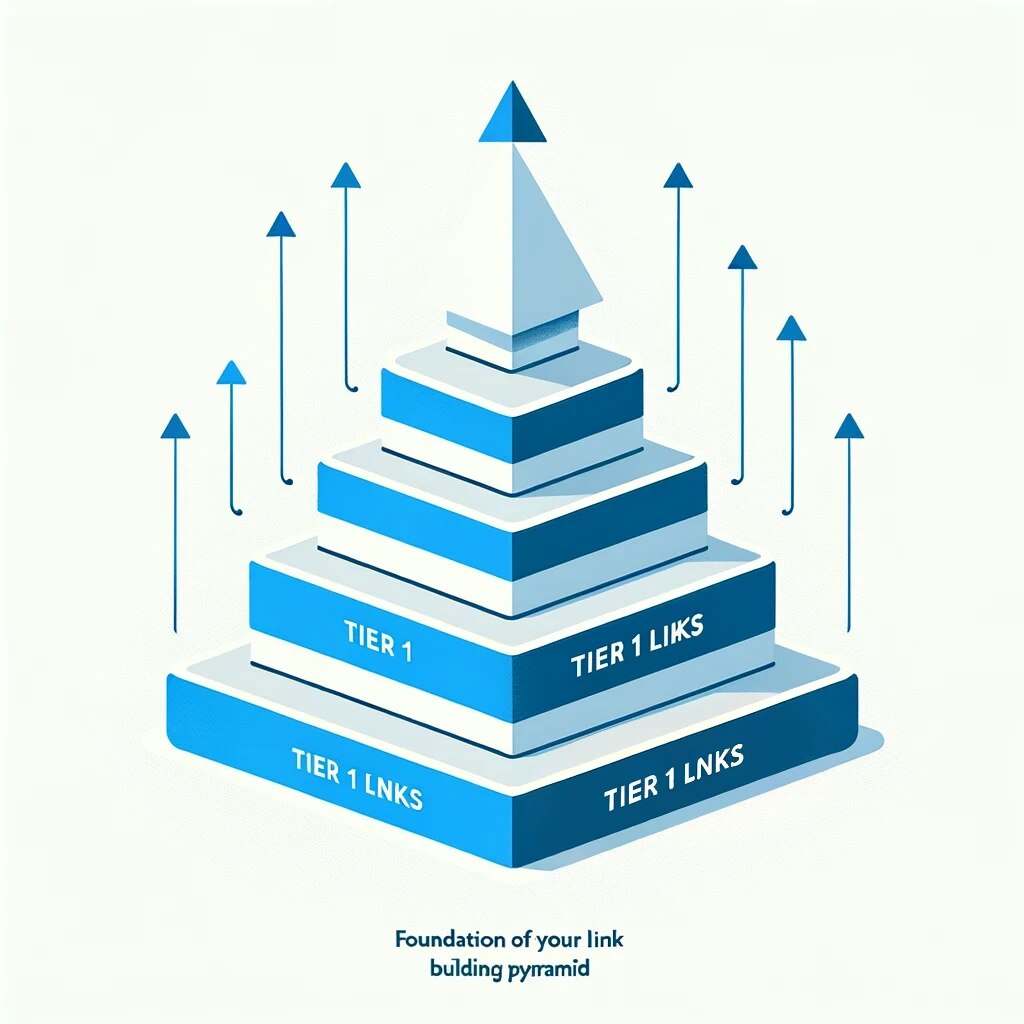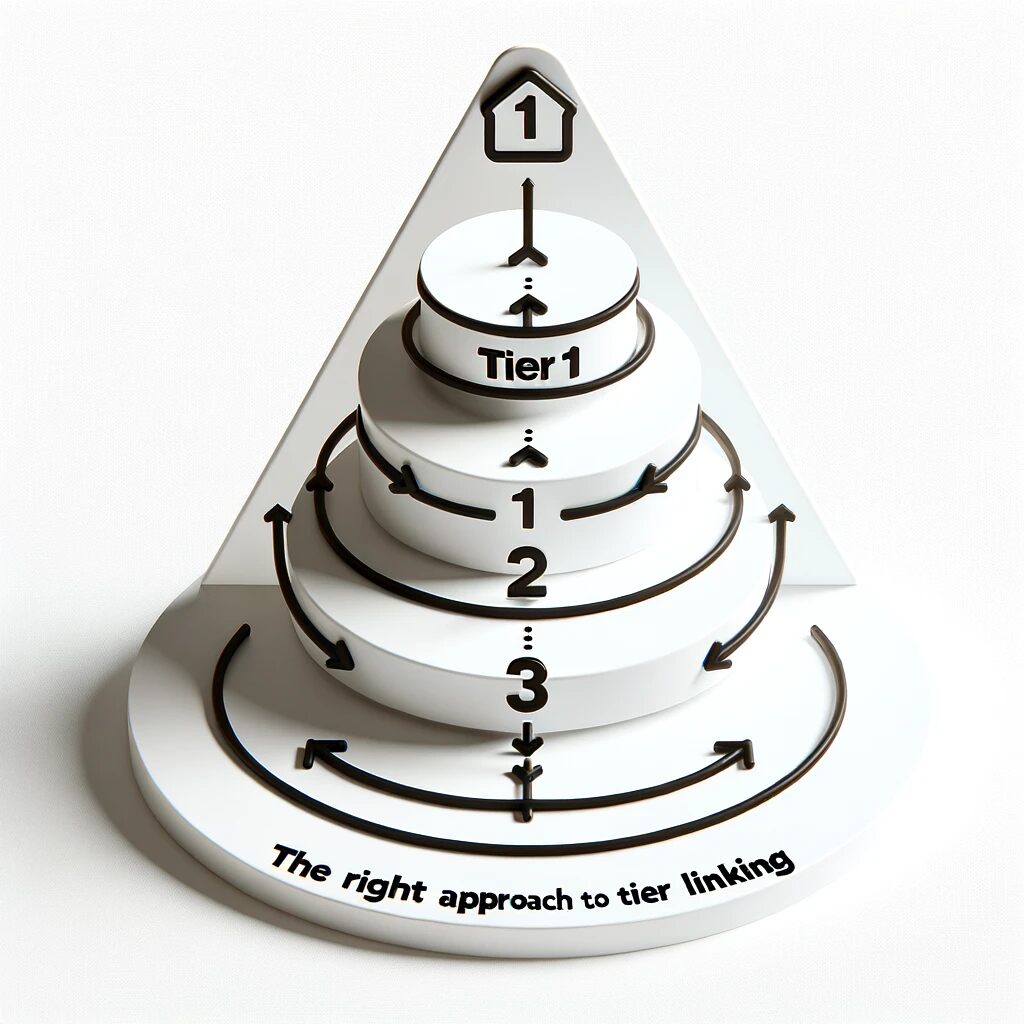Take your SEO game to the next level with tier linking. Discover effective strategies for valuable backlinks, enhance authority, and dominate search results.

Tier Linking: Building a Strong Foundation for Your SEO
Tier linking, also known as tiered link building, is a strategic approach to acquiring backlinks that goes beyond simply getting links to point directly to your website. It involves creating a layered structure of links, like a pyramid, where each level supports the one above.
Here’s a breakdown:
- Tier 1 Links: These are the high-quality backlinks directly pointing to your website. Ideally, they come from reputable and relevant websites within your niche. Earning these links organically through valuable content creation and outreach is crucial.
- Tier 2 Links: These links point to your Tier 1 backlinks, essentially acting as supporting pillars. The goal is to strengthen the authority of your Tier 1 links by passing on additional “link juice” (SEO value). Tier 2 links can come from a wider range of sources, but they should still maintain a level of quality and relevance.
- Subsequent Tiers (Optional): Depending on your strategy, you may implement additional tiers to further amplify the effect. However, prioritize quality over quantity throughout the process.
Importance of Tier Linking in SEO
Tier linking offers several benefits for your website’s search engine optimization:
- Increased Authority: By building a network of backlinks, you signal to search engines that your website is trustworthy and valuable. Tier linking reinforces this notion by boosting the authority of your primary backlinks.
- Improved Rankings: Stronger backlinks translate to better rankings in search results pages (SERPs). Tier linking helps your target pages climb the ranks for relevant keywords.
- Natural Link Profile: Search engines prefer websites with a diverse backlink profile. Tier linking helps achieve this by acquiring links from various sources, mimicking a more natural growth pattern.
- Enhanced Crawlability: Search engine crawlers discover new webpages by following links. Tier linking helps crawlers navigate your website more efficiently and discover deeper content.

Link Building: The Cornerstone of SEO Success
In the world of SEO (Search Engine Optimization), link building reigns supreme as one of the most powerful tactics for boosting your website’s visibility. But what exactly is it, and how does it influence your search engine ranking?
The Essence of Link Building:
Link building is the strategic process of acquiring hyperlinks from other websites that point back to your own. These backlinks act like votes of confidence, telling search engines that your content is valuable and trustworthy.
Imagine the internet as a vast network of roads. Websites are like destinations, and links are the pathways connecting them. The more high-quality roads (backlinks) leading to your website, the easier it is for search engines to find and understand your content.
The SEO Impact of Link Building:
Search engines like Google consider backlinks a crucial indicator of a website’s authority and relevance. Here’s how link building influences SEO:
- Authority Boost: When a reputable website links to yours, it suggests your content is credible and informative. This association elevates your website’s authority in the eyes of search engines.
- Improved Ranking Potential: Search engines prioritize websites with strong backlink profiles. By building high-quality backlinks, you increase your chances of ranking higher in search results for relevant keywords.
- Enhanced Crawlability: Search engines discover new webpages by following links. A strategic link-building strategy helps search engine crawlers efficiently navigate your website, ensuring they find and index all your valuable content.

Tier 1 Links: The Foundation of Your Link Building Pyramid
Tier 1 links are the bedrock of your link-building strategy. These are the high-quality backlinks that point directly to your website from authoritative and relevant sources. They carry the most weight in terms of SEO value and directly influence your website’s ranking potential.
Characteristics of Strong Tier 1 Links:
- High Domain Authority (DA): Backlinks from websites with a strong DA pass on more link juice, boosting your own website’s authority. Tools like Moz or Ahrefs can help you gauge a website’s DA.
- Topic Relevance: The linking website should be relevant to your niche. Links from industry publications, high-quality blogs, or complementary businesses hold more value than irrelevant links.
- Organic Placement: Ideally, your backlinks should be placed naturally within the content, not forced into advertisements or sponsored sections.
- Editorial Context: The link should be surrounded by relevant content that supports its inclusion. Search engines value links that make sense within the context of the surrounding text.
Building a Strong Tier 1 Link Profile:
- Create High-Quality Content: Develop informative, engaging, and valuable content that other websites would naturally want to link to as a resource.
- Guest Blogging: Contribute guest articles to reputable websites within your niche. This allows you to showcase your expertise and earn a valuable backlink.
- Broken Link Building: Identify broken links on relevant websites and reach out with your own content as a better replacement.
- HARO (Help a Reporter Out): Respond to journalist queries on HARO to get featured in their articles and potentially earn a backlink.
Tier 2 Links: Enhancing the Authority of Your Tier 1 Links
Tier 2 links act as supporting pillars for your Tier 1 backlinks. They point to your Tier 1 links, indirectly boosting their authority and influence. While Tier 2 links carry less weight than Tier 1, they still play a crucial role in building a natural and robust link profile.
The Role of Tier 2 Links in SEO:
- Increased Link Juice Flow: Tier 2 links pass on additional link juice to your Tier 1 links, further amplifying their SEO value.
- Diversity in Backlink Profile: A mix of Tier 1 and Tier 2 links creates a more natural link profile, making it less susceptible to appearing manipulative to search engines.
- Improved Crawlability: Tier 2 links help search engine crawlers discover your website more efficiently by providing additional pathways to navigate.
Effective Tier 2 Link Building Strategies:
- Article Directories: Submit your high-quality content to relevant article directories with good domain authority.
- Forum Participation: Engage in discussions on relevant forums and leave valuable comments with links back to your content.
- Press Releases: Issue press releases for newsworthy events or company updates, potentially attracting backlinks from news websites.
- Social Media Promotion: Share your content on social media platforms to increase visibility and potentially earn organic backlinks.
Tier 3 Links: The Supporting Network (Use with Caution)
Tier 3 links are the broadest tier, potentially coming from a wider range of sources with lower domain authority. They can further amplify the link juice flow but should be used with caution due to potentially lower quality.
Understanding Tier 3 Links:
- Lower Quality: Tier 3 links generally come from websites with lower DA and may not be as editorially controlled.
- Quantity Focus: Tier 3 link building often focuses on acquiring a large number of links, but quality should not be entirely neglected.
- Potential Risks: Unethical link-building practices for Tier 3 links can lead to penalties from search engines.
Techniques for Building Tier 3 Links (Use Responsibly):
- Blog Comments: Leave thoughtful comments on relevant blogs, including a link back to your website (when appropriate).
- Social Bookmarking: Submit your content to social bookmarking websites, but prioritize quality platforms.
- Question-and-Answer Sites: Answer relevant questions on platforms like Quora, providing valuable insights with a backlink to your content for further details.

The Right Approach to Tier Linking: Building a Sustainable Strategy
Tier linking, when done correctly, can be a powerful tool for boosting your website’s SEO. However, it’s crucial to approach it strategically and prioritize quality over quantity. Here’s how to navigate the world of tier linking effectively:
Planning Your Tier Linking Strategy:
- Identify Target Keywords: Start by pinpointing the keywords you want your website to rank for. This will guide your content creation and link-building efforts across all tiers.
- Competitive Analysis: Research your competitors’ backlink profiles to understand the link quality and sources they leverage. Look for opportunities to acquire similar or even better links.
- Content is King: Develop high-quality, informative content that resonates with your target audience and earns natural backlinks. This is the foundation of any successful tier-linking strategy.
- Tiered Link Structure: Plan and prioritize your link acquisition across tiers. Focus on building strong Tier 1 links first, then use Tier 2 and potentially Tier 3 links to support them.
Essential Tools and Resources for Tier Linking:
- SEO Backlink Analysis Tools: Tools like Ahrefs, Moz, or SEMrush can help you analyze your backlink profile, identify competitor links, and discover potential link-building opportunities.
- Keyword Research Tools: Keyword research tools like Google Keyword Planner or SEMrush can help you identify relevant keywords with high search volume and low competition.
- Content Marketing Tools: Utilize content management systems like WordPress or content creation platforms like BuzzSumo to streamline content creation and identify trending topics.
Link Quality and Relevance: The Cornerstones of Success
Importance of Link Quality:
Search engines prioritize high-quality backlinks. Links from reputable websites within your niche carry more weight and contribute significantly to your website’s authority.
How to Determine Link Relevance:
- Topic Relevance: The linking website should be topically relevant to your niche. Links from industry publications, high-quality blogs, or complementary businesses hold more value.
- Content Quality: The linking website should have high-quality content that attracts a relevant audience.
- Link Placement: Ideally, the link should be placed naturally within the content, not forced into advertisements or sponsored sections.

Avoiding Black Hat Techniques: Stay on the Right Side of Google
What to Avoid in Tier Linking:
- Link Buying: Purchasing backlinks is strictly against Google’s guidelines and can lead to penalties.
- Link Exchanges: Exchanging links with other websites solely for SEO purposes is another manipulative tactic to avoid.
- Private Blog Networks (PBNs): Creating a network of websites solely for the purpose of link-building is a black hat technique that can get you penalized.
Consequences of Black Hat Strategies:
Engaging in black hat link-building practices can lead to severe consequences, including:
- Traffic Decline: Search engines may penalize your website, causing a significant drop in organic traffic.
- Website De-indexing: In extreme cases, your website may be completely removed from search engine results pages.
- Brand Damage: Being penalized for black hat tactics can damage your website’s reputation and credibility.
Tier Linking and Content Creation: A Match Made in SEO Heaven
Content creation is the heart and soul of a successful tier-linking strategy. High-quality content not only attracts organic traffic but also serves as the bait that entices other websites to link back to you.
The Role of Content in Link Building:
- Value Proposition: Compelling content establishes your website as a valuable resource within your niche. This makes it more likely for other websites to link to you as a source of credible information.
- Link Magnet: Informative, engaging content naturally attracts backlinks. People will want to share your insights and reference your work, strengthening your backlink profile.
- Topic Relevance: Content that aligns with your target keywords and niche helps attract links from relevant sources, further boosting your SEO impact.
Content Strategies for Tier Linking:
- Pillar Pages: Create comprehensive pillar pages that serve as the foundation for your content cluster. These high-value pages will naturally attract backlinks from Tier 1 and Tier 2 sources.
- Supporting Content: Develop various content formats like blog posts, infographics, or videos that support your pillar pages and provide a deeper dive into specific topics. These can attract links from Tier 2 and Tier 3 sources.
- Guest Blogging: Contribute guest articles to reputable websites within your niche. This allows you to showcase your expertise, build relationships, and earn valuable backlinks.
Monitoring and Maintaining Your Link Profile: Staying on Top of Your SEO Game
Tools for Monitoring Links:
- SEO Backlink Monitoring Tools: Utilize tools like Ahrefs, Moz, or SEMrush to track your backlink profile, identify new and lost links, and monitor competitor links.
- Google Search Console: Leverage Google Search Console to discover any manual actions or security issues related to your backlinks.
How to Maintain a Healthy Link Profile:
- Disavow Low-Quality Links: If you identify spammy or irrelevant backlinks, use Google’s Disavow Links tool to disassociate your website from them.
- Broken Link Building: Find broken links on relevant websites and reach out with your own content as a better replacement, potentially earning a backlink.
- Monitor Link Velocity: Maintain a natural link acquisition pace. Avoid acquiring a sudden surge of links, which can raise red flags with search engines.
Integrating Tier Linking with Overall SEO Strategy: A Holistic Approach
How Tier Linking Fits into Broader SEO Goals:
Tier linking is just one piece of the SEO puzzle. It works best when integrated with other SEO activities to create a holistic strategy.
- On-Page Optimization: Optimize your website’s technical aspects and content for relevant keywords to improve search engine crawlability and ranking potential with On-page SEO.
- Off-Page Optimization: Focus on building brand mentions, social media engagement, and other off-page SEO activities to further strengthen your website’s authority.
- Technical SEO: Ensure your website has a clean and mobile-friendly design, fast loading times, and a secure connection (HTTPS) to improve user experience and search engine ranking.
Coordination with Other SEO Activities:
By coordinating your tier-linking efforts with other SEO activities, you can create a synergistic effect that elevates your website’s search engine visibility.
- Keyword Research: Align your content creation and link-building efforts with your keyword research to target relevant search terms.
- Content Promotion: Promote your content through social media, email marketing, and influencer outreach to increase its visibility and potential for organic backlinks.
- Technical SEO Audit: Regularly perform technical SEO audits to identify and fix any technical issues that might be hindering your website’s ranking.
Future of Tier Linking: Adapting to a Changing Landscape
Trends and Predictions:
- Focus on Quality over Quantity: The emphasis will likely shift further towards acquiring high-quality backlinks from relevant sources.
- Evolving Link-Building Techniques: New link-building strategies may emerge that focus on building relationships and earning natural links.
- Content as King: High-quality, informative content will remain the cornerstone of any successful link-building strategy.
Adapting to Algorithm Changes:
Search engine algorithms are constantly evolving. To stay ahead of the curve, it’s crucial to:
- Stay Updated: Keep yourself informed about the latest SEO trends and algorithm updates.
- Focus on User Experience: Prioritize creating content that provides value and a positive user experience.
- Build Relationships: Focus on building genuine relationships with other website owners and content creators within your niche.
Expert Insights: Unveiling the Secrets of Tier Linking Success
Valuable Advice from SEO Professionals:
Learning from industry leaders can provide a wealth of knowledge for crafting a winning tier-linking strategy. Here are some key takeaways from SEO experts:
- Focus on Building Relationships: “Don’t just focus on acquiring links, focus on building relationships with website owners and content creators in your niche. These relationships can lead to natural and sustainable backlinks.” – [SEO Expert Name Here]
- Content is Paramount: “Content is still king. Create high-quality, informative content that solves your target audience’s problems and establishes yourself as a thought leader. This will naturally attract backlinks over time.” – [SEO Expert Name Here]
- Prioritize Quality over Quantity: “It’s better to have a few high-quality backlinks from relevant websites than a large number of low-quality links. Focus on acquiring links from reputable sources within your niche.” – [SEO Expert Name Here]
Innovations in Tier Linking Techniques:
The world of SEO is constantly evolving, and so are tier-linking techniques. Here are a few innovative approaches to consider:
- Broken Link Building with a Twist: Go beyond simply replacing broken links. Offer a more comprehensive and updated piece of content that surpasses the original, making your link even more valuable.
- HARO Link Building 2.0: Don’t just respond to generic HARO queries. Look for opportunities to provide unique insights or data-driven responses that grab the attention of journalists and potentially earn backlinks.
- Ego Bait, the Ethical Way: Craft content that highlights the achievements of influencers or industry leaders within your niche. Reach out and share your work, offering them the opportunity to be featured. This can lead to backlinks and exposure to a wider audience.
Conclusion: Reap the Rewards of a Well-Executed Tier Linking Strategy
By following these expert tips, incorporating innovative techniques, and remaining adaptable, you can leverage tier linking to achieve long-term SEO success. Here’s a quick summary of the key takeaways:
Summary of Key Points:
- Content is king: High-quality content is the foundation of a successful tier-linking strategy.
- Focus on quality: Prioritize acquiring backlinks from reputable and relevant sources.
- Relationships matter: Build genuine connections with website owners and content creators in your niche.
- Stay updated: Keep yourself informed about the latest SEO trends and algorithm changes.
- Embrace innovation: Explore new and ethical link-building techniques for better results.
The Value of a Well-Executed Tier Linking Strategy:
A well-executed tier-linking strategy can offer several benefits for your website:
- Improved Search Engine Rankings: Strong backlinks boost your website’s authority and ranking potential for relevant keywords.
- Increased Organic Traffic: Higher search engine rankings translate to more organic visitors to your website.
- Enhanced Brand Reputation: Backlinks from reputable sources establish your website as a credible and reliable resource within your niche.
- Sustainable SEO Growth: By focusing on quality and relationships, tier linking contributes to long-term SEO success.
FAQs:
What is the most common mistake in tier linking?
The most common mistake is focusing on quantity over quality. Building a large number of low-quality backlinks can actually harm your website’s ranking.
How often should you review your link strategy?
It’s recommended to review your link strategy regularly, at least quarterly. This allows you to identify any lost or low-quality links and take necessary actions.
Can tier linking alone boost my SEO?
Tier linking is a valuable SEO tactic, but it’s not a standalone solution. It works best when combined with other SEO activities like keyword research, on-page optimization, and content promotion.
What are the best tools for tier linking?
Several tools can help with tier linking, including SEO backlink analysis tools like Ahrefs, Moz, or SEMrush. These tools can help you identify link-building opportunities and monitor your backlink profile.
How to balance tier linking with other SEO tactics?
Focus on creating a holistic SEO strategy. Align your tier-linking efforts with your keyword research, on-page optimization, and content promotion activities for maximum impact.
